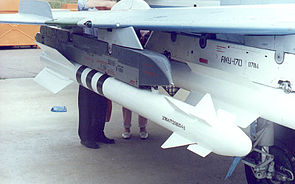Wympel R-73
| R-73E | |
|---|---|
| General Information | |
| Type | Air-to-air missile |
| Manufacturer | GMKB pennant |
| development | 1970s |
| Commissioning | 1980s |
| Technical specifications | |
| length | 2.9 m |
| diameter | 170 mm |
| Combat weight | 110 kg |
| span | 510 mm |
| drive | Solid motor with thrust vector control |
| speed | 1,005 m / s |
| Range | 30 km |
| Furnishing | |
| Target location | Inertial navigation plus passive infrared steering |
| Warhead | 7.4 kg continuous rod |
| Detonator | Laser / radar proximity and impact detonators |
| Lists on the subject | |
The R-73 ( NATO code name : AA-11 “Archer” ) is a Russian , formerly Soviet , infrared guided short-range air-to-air missile of the third generation.
development
The R-73 was developed as the successor to the R-60 . Development at the manufacturer Wympel ( Russian Вымпел ) began in the Soviet Union in the late 1970s. The first copies were delivered to the Soviet air force in the mid-1980s . After that, more than 20 states procured the guided missile.
technology
The guided weapon was specially designed for cornering combat, and it has enough reserves to fight targets at a distance of up to 40 kilometers. It has a thrust vector control that is implemented with a jet rudder unit on the nozzle. The missile is designed for load multiples of up to 50 g , whereas combat aircraft can hardly exceed 9 g due to the limited load capacity of the pilots .
The seeker head of the R-73 has a large "field of view" of 75 degrees and, in conjunction with the SchTschel-3UM helmet visor ( Russian Щель-3УМ ), can be fired at aircraft that are up to 60 ° (R-73M) from the Longitudinal axis of your own aircraft are removed. The rocket is instructed on its target by moving the head in conjunction with the pilot's helmet visor. If the target comes within the proximity fuse's response radius, the fragmentation warhead is detonated. The warhead of the R-73 contains an explosive filling made of an RDX - aluminum mixture, which is embedded in a fragmentation jacket made of depleted uranium .
It is said to be far superior to its western counterparts ( AIM-9L Sidewinder , BAE ASRAAM, Matra Mica and Matra Magic 2 ) in terms of maneuverability, accuracy and range. In contrast to the Sidewinder, it can also be used against targets outside the pilot's view . Until the introduction of the new AIM-9X version of the Sidewinder and the IRIS-T, the R-73 was considered the world's most powerful short-range air-to-air guided missile.
The guided missile is usually mounted on a P-12-1D launch rail and wired to be fired from there.
variants

- R-73
- This first production version had a range of 20 km.
- R-73E
- Improved 2nd series version with improved seeker head, four flight position sensors and an extended rocket propulsion unit. This enables target assignment with a helmet visor and an increased range of 30 km.
- R-73EL
- Variant of the R-73E with a laser proximity fuse.
- R-73M
- Version introduced in 1996 with improved electronics and modified seeker head, which can detect targets in a field of view of 180 °. The range has been increased to 40 km.
- R-74
- Prototype with new electronics and a new Karfagen 760 seeker head that works on two bandwidths in the infrared and ultraviolet range; Range 40 km.
- R-74MK
- Intended production version of the R-74 for the fifth generation fighter aircraft. With radar proximity fuse; Range 40 km.
- R-74ML
- Variant of the R-74 with a laser proximity fuse.
- R-74M2
- Variant of the R-74 for use from weapon bays
- RWW-MD
- Export version of the R-74.
- USR-73
- Training variant with an active seeker head without rocket propellant.
Emergency aircraft
- Prototypes
- Jakowlew Jak-141 (NATO code name "Freestyle")
- HAL Tejas
- Mikoyan-Gurevich MiG-21-93 ("Fishbed")
- Mikoyan-Gurewitsch MiG-23-98 ("Flogger")
- Mikoyan-Gurewitsch MiG-35 ("Fulcrum-E")
- Series machines
- Jakowlew Jak-130 ("Middle")
- Mikoyan-Gurewitsch MiG-23MLD ("Flogger-K")
- Mikoyan-Gurewitsch MiG-29S ("Fulcrum-C")
- Mikojan-Gurewitsch MiG-31BM ("Foxhound")
- Sukhoi Su-24M2 ("Fencer-D")
- Sukhoi Su-25SM / UBM ("Frogfoot")
- Suchoi Su-25TM ("Frogfoot")
- Sukhoi Su-27P ("Flanker-B")
- Suchoi Su-30 ("Flanker-C")
- Suchoi Su-27K / 33 ("Flanker-D")
- Sukhoi Su-32/34 ("Fullback")
- Suchoi Su-35S ("Flanker-E")
- Sukhoi Su-57
- Grumman F-14A "Tomcat" (Iranian Air Force, IAIC has had its own MLU since 2005, including an upgrade to R-73)
- Attack helicopter
- Mil Mi-28NM ("Havoc")
- Kamow Ka-52 ("Hokum-B")
literature
- Jane's Air-Launched Weapon Systems , Jane's 2002
- The AA-11 Archer air-to-air guided missile system. , DTIG - Defense Threat Informations Group (ed.), January 1998.
- Russia's Arms 2004 catalog. , Military Parade Publishing House.
Individual evidence
- ^ Jefim Gordon : Soviet / russian aircraft weapons since world war two . Midland, 2004, pp. 33 .
- ↑ a b c d Piotr Butowski: Russia is preparing a precision guidance revolution for its fast jet, strike, and bomber forces . Jane's International Defense Review, August 2014, United Kingdom, 2014.

